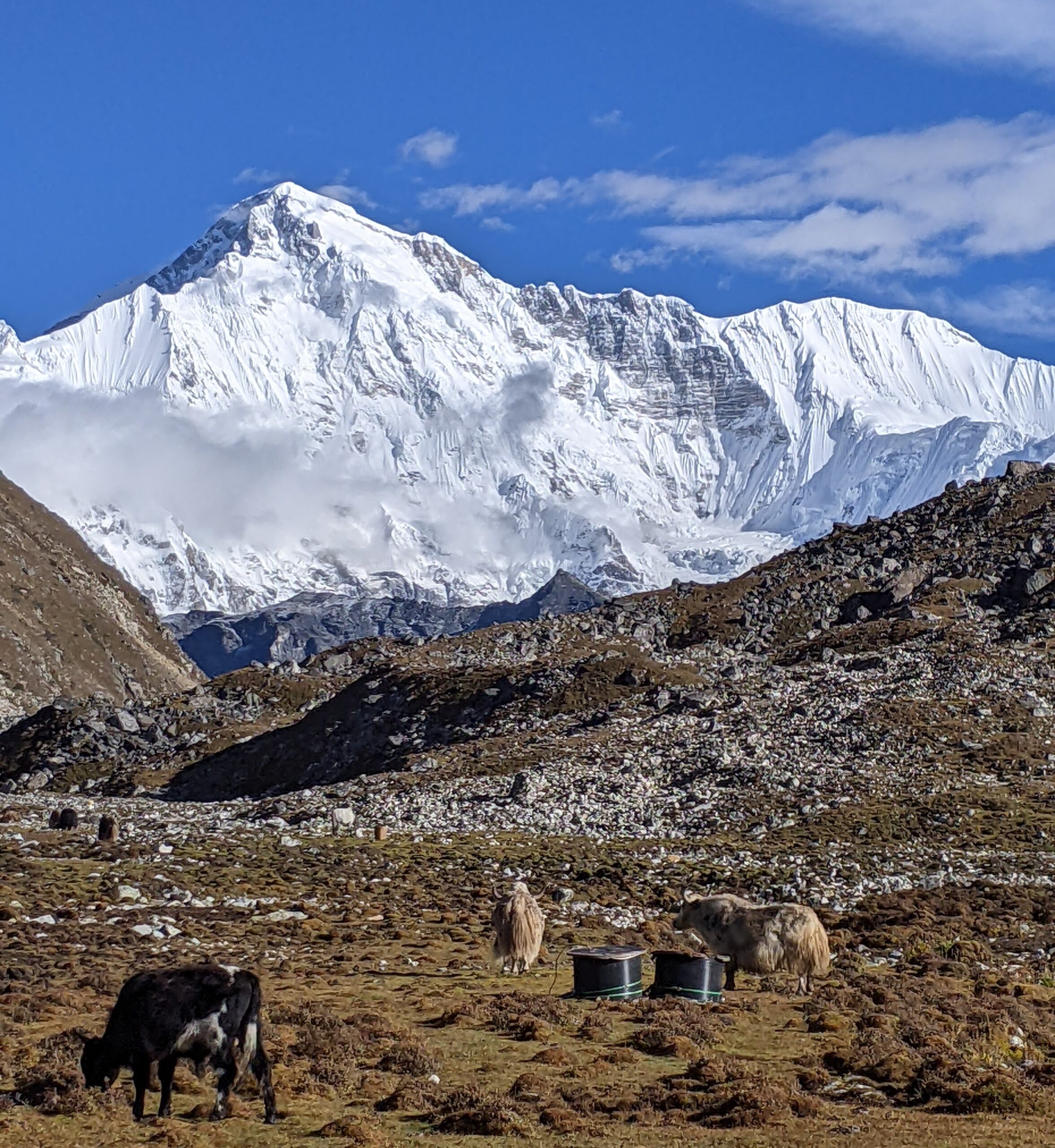Image: Yaks & a cow grazing at Gokyo
Post 6 of 6
6 October 2022
Arriving in Lukla to start the trek, we were enamoured by the lush green mountains looming over the deep long valleys with rapid rivers cutting through at a panicked pace. As we increased in altitude the majestic snow-capped Himalayas started to reveal themselves and the vegetation around us shrank in size and density. Signs told us that we were walking through forests of rhododendron and that the plant is native to the Himalayas and is Nepal’s national flower. Unfortunately for us, rhododendrons do not flower in Autumn.
The vegetation drastically reduced after 4500m at Dengboche. Up to about 5000m, the hills were covered in swathes of small shapely flowers in varied colours including red, yellow, purple, blue, pink, white and black. The frost and ice of the early morning would make the flowers sparkle as the first rays of daylight reached us, keeping my mind off the task at hand – breathe, walk, breathe, walk. As we finished our trek, the Autumn colours had arrived in the lower altitudes changing the landscape again.
Most of the wildlife we came across was of the avian variety. Apparently the wolves, snow leopards and mountain deer can sniff a human way before we could ever see one. We saw a variety of Mountain Finches and Thrush, Vultures and Eagles, many Grandala (a beautiful bright blue bird) and lots and lots of Choughs. My favourite was the entertaining Snowcocks. They are in the pheasant family, live high in the mountains and can survive temperatures down to -40 degrees Celsius. They are a bit on the chunky side, so if they want to fly, they waddle or rock hop to higher levels and then launch themselves off, flapping their wings and sort of gliding to where they want to go. The Snowcocks have a pleasant call and are quite chatty. They fan their long tail feathers into a stunning display to win favour or ward off baddies which, when combined with their chunky frame and preference to hop rather than fly, makes for an amusing spectacle. I was too busy being entertained to take any photos, sorry.
Our route involved steep ups and downs on a path that changed shape and size as it found a way across the topography of the mountains. Every river crossing involved a long pedestrian suspension bridge, many which were vertigo inducing. We saw bridges that had collapsed or were inaccessible due to landslides. Along the valleys, it was a mostly rocky path rambling parallel to the raging rivers charging through the deep ravines. The mountain passes were tricky, at times terrifying, and involved many different terrains including rubble, loose soil, rocks, snow, dirt, boulders, and a few glaciers.

Humans, yaks, mules and horses all have to cross this bridge to get up the big hill
I can’t be sure if or when the monsoon finished because across our 21 days of walking, we saw sunset only once. Some days the cloud would arrive shortly after sunrise, other days the cloud would creep in after lunch. The variability in the cloud was enormous and we never knew what to expect as the mountain terrain makes weather forecasting difficult. The cloud would linger in the valleys, or hover around the tops of the mountains, or engulf us and everything around us, or disappear as swiftly as it arrived. We were thrilled every time the cloud allowed us a glimpse of the top of a mountain and I tried desperately to memorise the shape of each peak to help me remember the names. The cloud enhanced the drama of the landscape, the majesty of the mountains and the sense of adventure.
And while we got cloud constantly, we avoided any rain through a combination of good luck and walking mostly in the morning. We saw sunrise every day: many magical in some truly special places. The stunning mornings were almost an assault on the senses after the cloudy greys of the afternoons. Starting so early in the day meant we were able to take our time to really appreciate and value our surroundings and the experience. It was awesome.
As we said goodbye to Mt Everest and trekked down the west side of Renjo La and back below 4500m, it hit us that our time amongst the giants of the Himalayas was over. We had been so focused on climbing the last mountain, that we hadn’t processed what reaching the third and final pass of our trek meant. To put it simply, we were sad.
We spent our last few days in Kathmandu missing the open spaces, clean air and serenity of the mountains, but thoroughly enjoyed a shower, green vegetables and an ice-cream. And then it was time to go home.









